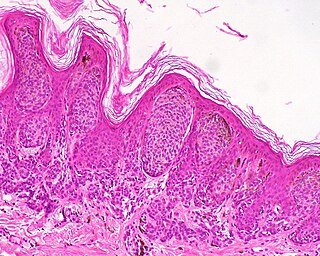
Activin A receptor, type I (ACVR1) is a protein which in humans is encoded by the ACVR1 gene; also known as ALK-2. ACVR1 has been linked to the 2q23-24 region of the genome. This protein is important in the bone morphogenic protein (BMP) pathway which is responsible for the development and repair of the skeletal system. While knock-out models with this gene are in progress, the ACVR1 gene has been connected to Fibrodysplasia Ossificans Progressiva, a disease characterized by the formation of heterotopic bone throughout the body. It is a Bone morphogenetic protein receptor, type 1.

Acute myeloblastic leukemia without maturation is a quickly progressing disease in which too many immature white blood cells are found in the blood and bone marrow.

Adenosquamous carcinoma is a type of cancer that contains two types of cells: squamous cells and gland-like cells. It has been associated with more aggressive characteristics when compared to adenocarcinoma in certain cancers.
ALVAC-CEA vaccine is a cancer vaccine containing a canary pox virus (ALVAC) combined with the carcinoembryonic antigen (CEA) human gene.
Antiestrogens, also known as estrogen antagonists or estrogen blockers, are a class of drugs which prevent estrogens like estradiol from mediating their biological effects in the body. They act by blocking the estrogen receptor (ER) and/or inhibiting or suppressing estrogen production. Antiestrogens are one of three types of sex hormone antagonists, the others being antiandrogens and antiprogestogens.

Atamestane, also known as metandroden, as well as 1-methylandrosta-1,4-diene-3,17-dione, is a steroidal aromatase inhibitor that was studied in the treatment of cancer. It blocks the production of estrogen in the body. The drug is selective, competitive, and irreversible in its inhibition of aromatase.

Atiprimod is a substance being studied in the treatment of certain multiple myelomas and other advanced cancers. It may block the growth of tumors and the growth of blood vessels from surrounding tissue to the tumor. This drug is also being researched as a potential treatment for various autoimmune diseases. It was first developed by GlaxoSmithKline as a potential treatment for rheumatoid arthritis. The substance is also known as azaspirane, although this more properly refers to the class of chemicals to which atiprimod belongs.

Treosulfan is a substance that is being studied in the treatment of cancer. It belongs to the family of drugs called alkylating agents. It has been used mainly as a substitute of busulfan in frail patients, as the side effects and toxicity are supposedly less severe.
A brain stem tumor is a tumor in the part of the brain that connects to the spinal cord.
Clear cell sarcoma of the kidney (CCSK) is an extremely rare type of kidney cancer comprising 3% of all pediatric renal tumours. Clear cell sarcoma of the kidney can spread from the kidney to other organs, most commonly the bone, but also including the lungs, brain, and soft tissues of the body.
Collagen disease is a term previously used to describe systemic autoimmune diseases, but now is thought to be more appropriate for diseases associated with defects in collagen, which is a component of the connective tissue.

A compound nevus is a type of mole formed by groups of nevus cells found in the epidermis and dermis.
Wedge resection is a surgical procedure to remove a triangle-shaped slice of tissue. It may be used to remove a tumor or some other type of tissue that requires removal and typically includes a small amount of normal tissue around it. It is easy to repair, does not greatly distort the shape of the underlying organ and leaves just a single stitch line as a residual.

Gliosarcoma is a rare type of glioma, a cancer of the brain that comes from glial, or supportive, brain cells, as opposed to the neural brain cells. Gliosarcoma is a malignant cancer, and is defined as a glioblastoma consisting of gliomatous and sarcomatous components.
Spindle cell carcinoma is a type of cancer that begins in the skin or in tissues that line or cover internal organs and that contains long spindle-shaped cells. It is also called sarcomatoid carcinoma.
In the various fields of healthcare, a population study is a study of a group of individuals taken from the general population who share a common characteristic, such as age, sex, or health condition. This group may be studied for different reasons, such as their response to a drug or risk of getting a disease.
A nicotine lozenge is a tablet that contains a dose of nicotine polacrilex which dissolves slowly in the mouth to release the nicotine. Nicotine lozenges are commonly found in 2mg and 4mg strengths although other strengths may be found. The nicotine is absorbed through the lining of the mouth and enters the blood vessels. It is used as an aid in nicotine replacement therapy (NRT), a process for smoking cessation. People using the lozenge should not smoke because of the increased risk of nicotine poisoning. Combination therapy can be employed by the use of nicotine lozenges and a nicotine patch to increase the chances of quitting tobacco successfully and permanently. The effects of the lozenge may be diminished from drinking anything fifteen minutes prior to taking the lozenge.

A junctional nevus is a mole found in the junction (border) between the epidermis and dermis layers of the skin.
A neuroectodermal tumor is a tumor of the central or peripheral nervous system.
Segmental resection is a surgical procedure to remove part of an organ or gland, as a sub-type of a resection, which might involve removing the whole body part. It may also be used to remove a tumor and normal tissue around it. In lung cancer surgery, segmental resection refers to removing a section of a lobe of the lung. The resection margin is the edge of the removed tissue; it is important that this shows free of cancerous cells on examination by a pathologist.










